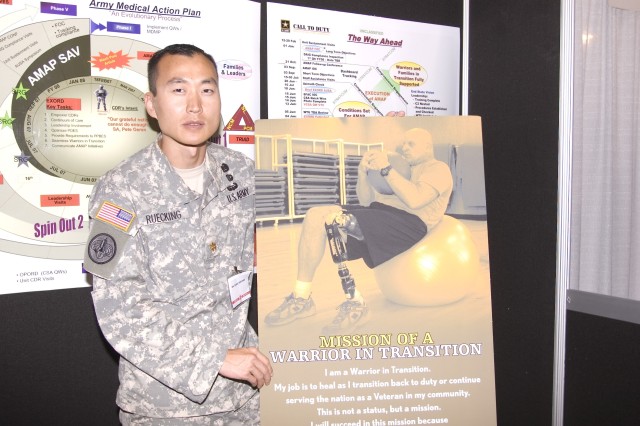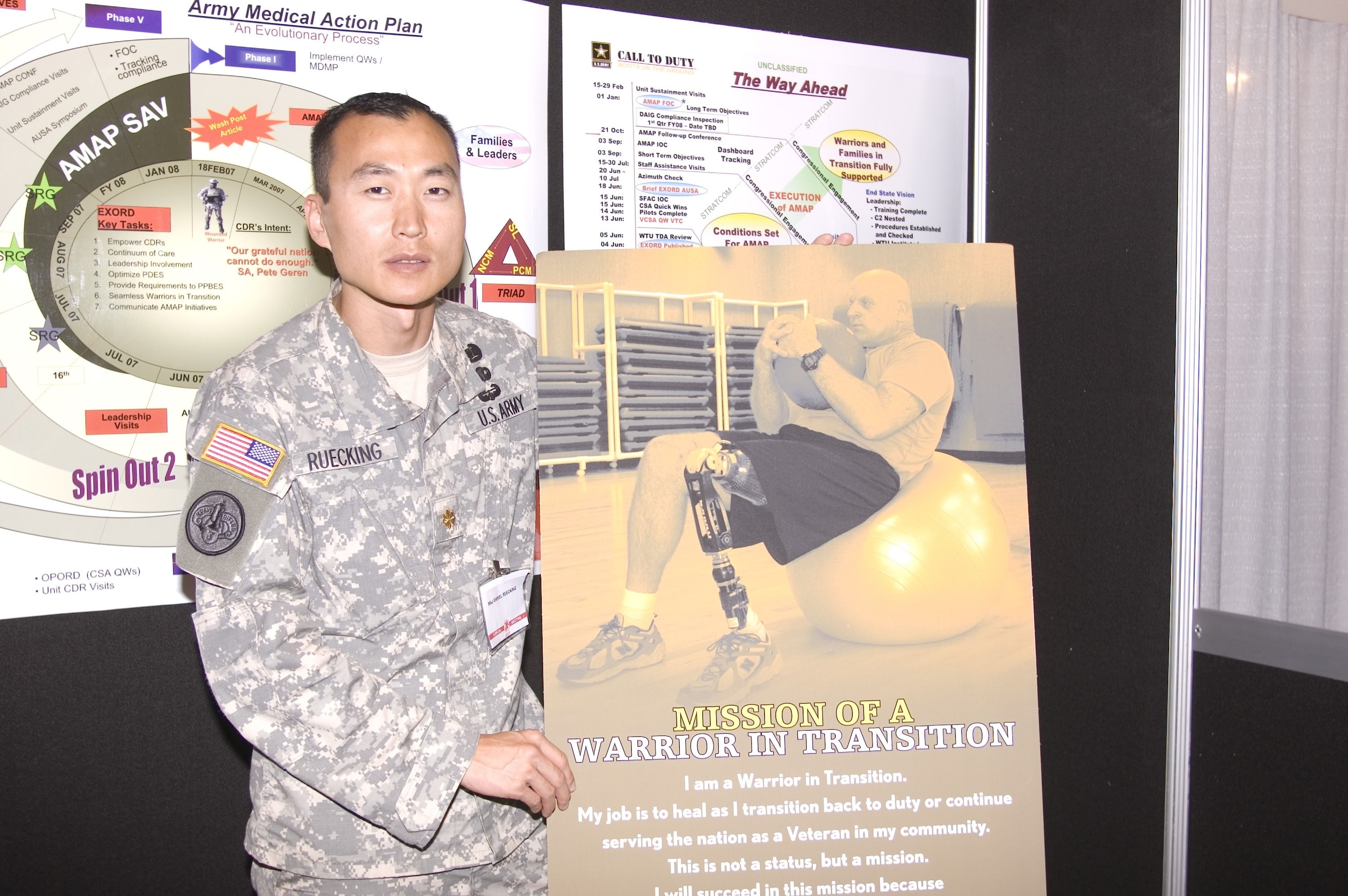WASHINGTON (Army News Service, Oct. 8, 2007) - The Army is establishing 32 "Warrior Transition Units" at major installations across the force to streamline care for wounded Soldiers.
The new units are the centerpiece of the Army Medical Action Plan headed up by Brig. Gen. Mike Tucker. His AMAP team went to work in June and identified about 150 items in the system that needed improving, he said during a panel presentation today at the annual meeting of the Association of the U.S. Army.
Better housing for wounded Soldiers was one of the improvements. The Army has allocated $173.5 million in Operations and Maintenance funding and another $1.2 billion in Military Construction funds for Warrior Transition Unit facilities and projects, said Maj. Gen. John MacDonald of the Installation Management Command.
"The Army is putting its money where its mouth is," Maj. Gen. MacDonald said. "...So that we have close to the hospitals a set of barracks that is accessible."
The new Warrior Transition Units will do much more than replace Medical Hold Companies, said the Army's acting Surgeon General, Maj. Gen. Gale S. Pollock. She said the units will combine what used to be separate structures for the active and reserve components and bring a new level of care to all patients.
Prior to the creation of the WTUs, most active-component Soldiers requiring complex treatment remained assigned to their parent units or to a rear detachment. Some were assigned or attached to Medical Hold Companies overseen by the Army Medical Command. Reserve Component Soldiers were managed differently, attached to Medical Hold-Over Companies overseen by the Army Installation Management Command.
The Army Medical Command expects to staff WTUs with 2,419 cadre by Jan. 1, the date set for the new units to become fully operationally. The staffing will ultimately include 743 active-component Soldiers, 381 National Guard Soldiers, 381 Army Reserve Soldiers, and 914 Army Civilians, whom are to support an estimated population of 10,000 Warriors in Transition.
A "Triad of Support" is what Medical Command calls a key element of the WTU cadre. The triad consists of a Primary Care Manager, who is a physician; a Nurse Case Manager, who is a registered nurse; and a squad leader, usually at the rank of staff sergeant.
There will be a squad leader for every 12 patients, said Col. Terry McKenrick, WTU brigade commander. He said in the past, many Medical Hold companies had a staff sergeant who administered to about 50 patients, and some of these did it on a part-time basis when not serving as an x-ray technician or other staff member.
A typical WTU company will have a commander, executive officer, first sergeant, six platoon sergeants and 18 squad leaders, Col. McKenrick said.
The squad leader will meet a patient and his family at the airport, Brig. Gen. Tucker said. Then they will be escorted to the Soldier and Family Assistance Center for in-processing.
The SFAC is a "one-stop" shop, Maj. Gen. MacDonald said. "We can bring the lawyer to (wounded warriors). We can bring the chaplain to them... so that they won't have to run all over post."
SFACs also help with documents, payments, access cards, benefit applications, and services coordination.
In addition to those at WTUs, "Virtual SFACs" are being established online.
"Soldiers can now log onto AKO and see their own case file ... and track their care," Brig. Gen. Tucker said, explaining that the joint application tracking is available under "My PEB" as part of Army Knowledge Online.
As Soldiers go through the Physical Evaluation Board process, they will have access to Staff Judge Advocate officers, Brig. Gen. Tucker said. He said 18 SJA officers have been activated for the WTUs.
"When we talk about 'holistic' care," said Dr. (Col.) Elspeth Ritchie, Behavioral Health Consultant to the Army Surgeon General, "we talk about the whole person. Holistic care, as the Army doctor describes, is about not only the medical aspects of healing, but the psychological, social, and cognitive aspects in conjunction with the Soldier's career goals and aspirations."
"It's about healing the entire Soldier," Brig. Gen. Tucker said. He said whatever makes a Soldier feel better and heal faster will be considered under the program. For instance, he said that allowing WTU Soldiers to wear the patches and insignia of their original units will make some in the program feel better, and that's been authorized.
The WTU mission is to facilitate the healing and rehabilitation of Soldiers, return them to duty when possible, or to prepare them for a successful life as a veteran in their community.
"We want them to think about life after healing," Brig. Gen. Tucker said.






Social Sharing